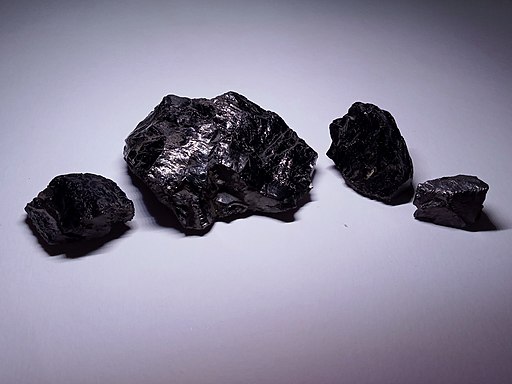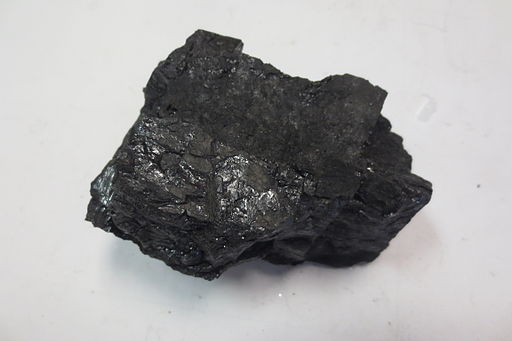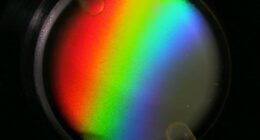Anthracite coal is harder, older, and has a higher carbon content than bituminous coal, which is softer and younger with a lower carbon content.
TL;DR Anthracite coal Vs. bituminous coal
Anthracite coal is the highest-quality coal, with high carbon content and low moisture. It burns efficiently, producing intense heat and minimal smoke, making it ideal for open fires. Bituminous coal is a mid-grade coal with higher carbon content than others but produces more emissions. Choose anthracite for cleaner and longer-lasting open fires.
What is anthracite coal?

Anthracite coal, also known as “hard coal,” is the crème de la crème of coals. It’s formed through a long and intense process of metamorphosis that involves high levels of heat and pressure. This results in a coal that has a high carbon content and low moisture content, making it incredibly dense and efficient for burning.
One distinguishing characteristic of anthracite coal is its shiny black appearance. Its lustrous surface sets it apart from other types of coal, giving it an almost jewel-like quality. In terms of texture, anthracite can be quite hard and brittle, which makes it difficult to break or crush.
When it comes to combustion properties, anthracite is known for producing hot flames with very little smoke or soot. This makes it ideal for use in home heating systems where clean-burning fuel is desired. Additionally, anthracite burns slowly and steadily, providing consistent heat over extended periods.
What is bituminous coal?

Bituminous coal is a type of coal that falls in the middle of the coal spectrum. It is formed from peat and undergoes significant heat and pressure over millions of years to become what it is today.
Bituminous coal is its carbon content, which ranges from 45% to 86%. This makes it a relatively high-grade fuel compared to other types of coal. In terms of energy output, bituminous coal produces more heat per unit than lower-grade coals.
When burned, bituminous coal releases sulfur dioxide into the atmosphere, contributing to air pollution and acid rain. However, advancements in technology have allowed for the development of clean-coal technologies aimed at reducing emissions.
Due to its relatively high energy output and availability in many regions worldwide, bituminous coal has been widely used for electricity generation and industrial processes such as steel production.
Anthracite coal Vs. bituminous coal – Key differences
| Characteristic | Anthracite Coal | Bituminous Coal |
|---|---|---|
| Carbon Content | High (86-97%) | Moderate (45-86%) |
| Energy Content | High heating value | Moderate heating value |
| Formation | Oldest and metamorphic | Younger and sedimentary |
| Hardness | Very hard | Relatively soft |
| Moisture Content | Low (1-15%) | Moderate to high (2-17%) |
| Sulfur Content | Low (0.2-2.8%) | Moderate to high (0.5-5%) |
| Ash Content | Low (2-16%) | Moderate to high (4-46%) |
| Usage | Residential heating, industry | Electricity generation, industry |
| Availability | Less abundant | More abundant |
| Environmental Impact | Cleaner burning, lower emissions | Higher emissions, air pollution |
How to choose the right type of coal for your needs?
- Identify your purpose: Determine the primary purpose for which you need coal. Different types of coal are suitable for various applications, such as residential heating, electricity generation, industrial processes, or metallurgical purposes.
- Consider energy content: If you need coal for heating or power generation, consider the energy content of the coal. Anthracite coal has the highest energy content, followed by bituminous coal, sub-bituminous coal, and lignite.
- Assess moisture content: For combustion purposes, lower moisture content is preferred as it affects the efficiency of burning. Anthracite typically has lower moisture content compared to other coal types.
- Evaluate sulfur and ash content: If environmental concerns are significant, choose coal with lower sulfur and ash content. Burning coal with high sulfur content can lead to increased emissions of sulfur dioxide, which contributes to air pollution and acid rain.
- Consider hardness and grindability: In industrial applications or processes where coal needs to be ground to a fine powder, the hardness and grindability of the coal can be important factors.
- Check availability and cost: Some types of coal may be more readily available or cost-effective in your region. Consider the availability and cost of the coal type you are considering.
- Environmental impact: If sustainability and environmental impact are crucial, look for cleaner-burning coal with lower emissions.
- Seek expert advice: If you are unsure about the specific coal type you need, consult experts in the field, such as coal suppliers, energy consultants, or engineers, to get personalized recommendations based on your requirements.
- Regulatory compliance: Ensure that the chosen coal type complies with local regulations and environmental standards.
- Perform trials if possible: If you have the opportunity, conduct small-scale trials with different coal types to assess their performance and suitability for your needs.
Which coal is better for an open fire?
For an open fire, anthracite coal is generally considered better than other types of coal. Here’s why:
- High Heat Output: Anthracite coal has the highest carbon content and energy value among all coal types. It produces intense and long-lasting heat, making it ideal for providing a consistent and efficient heat source in an open fire.
- Low Smoke and Soot: Anthracite coal burns with minimal smoke and soot compared to other coal varieties. This is beneficial for open fires as it reduces the amount of ash and particulate matter emitted, leading to a cleaner and less smoky fire.
- Longer Burn Time: Due to its high carbon content and low moisture content, anthracite coal burns slowly and steadily. This means you’ll spend less time refueling and tending the fire.
- Easy to Light: Although anthracite coal can take a little longer to ignite compared to wood or other coals, it is still relatively easy to light with the right kindling and fire-starting techniques.
- Less Maintenance: Anthracite coal produces less residual ash compared to bituminous coal, which means you’ll have to clean out the fireplace less frequently.
Image Credits
Featured Image By – Nikolay Kovalenko on Unsplash
Image 1 By – ILoveAllTrees, CC BY-SA 4.0 <https://creativecommons.org/licenses/by-sa/4.0>, via Wikimedia Commons
Image 2 By – Amcyrus2012, CC BY 4.0 <https://creativecommons.org/licenses/by/4.0>, via Wikimedia Commons









